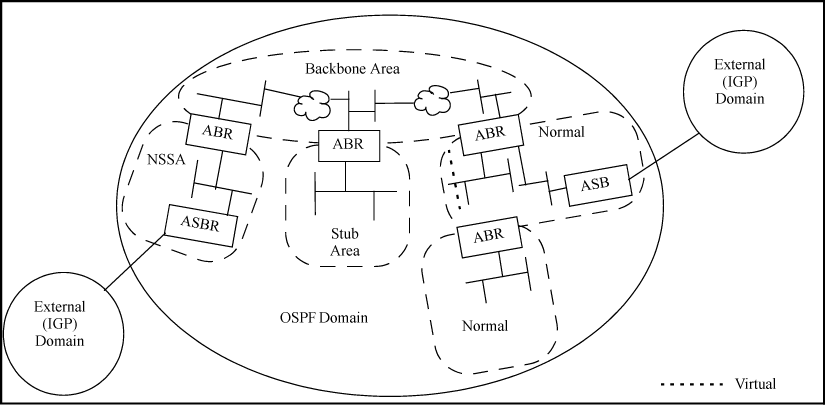OSPF is built upon a hierarchy of network areas. All areas for a given OSPF domain reside in the same AS. An AS is defined as a number of contiguous networks, all of which share the same interior gateway routing protocol.
An AS can be divided into multiple areas. Each area represents a collection of contiguous networks and hosts, and the topology of a given area is not known by the internal routers in any other area. Areas define the boundaries to which types 1 and 2 LSAs are broadcast, which limits the amount of LSA flooding that occurs within the AS and also helps to control the size of the LSDBs maintained in OSPF routers. An area is represented in OSPF by either an IP address or a number. Area types include:
|
|
All areas in an AS must connect with the backbone through one or more ABRs. If a normal area is not directly connected to the backbone area, it must be configured with a virtual link to an ABR that is directly connected to the backbone. The remaining area types do not allow virtual link connections to the backbone area.
Every AS must have one (and only one) backbone area (identified as area 0 or 0.0.0.0.) The ABRs of all other areas in the same AS connect to the backbone area, either physically through an ABR or through a configured, virtual link. The backbone is a transit area that carries the type-3 summary LSAs, type-5 AS external link LSAs and routed traffic between non-backbone areas, as well as the type-1 and type-2 LSAs and routed traffic internal to the area. ASBRs are allowed in backbone areas.
This area connects to the AS backbone area through one or more ABRs (physically or through a virtual link) and supports type-3 summary LSAs and type-5 external link LSAs to and from the backbone area. ASBRs are allowed in normal areas.
Beginning with software release K.12.xx, this area is available and connects to the backbone area through one or more ABRs. NSSAs are intended for use where an ASBR exists in an area where you want to control the following:
-
Advertising the ASBR's external route paths to the backbone area
-
Advertising the NSSA's summary routes to the backbone area
-
Allowing LSAs from the backbone area to advertise in the NSSA:
-
Summary routes (type-3 LSAs) from other areas
-
External routes (type-5 LSAs) from other areas as a default external route (type-7 LSAs)
-
In the above operation, the ASBR in the NSSA injects external routes as type 7 LSAs. (Type 5 LSAs are not allowed in an NSSA.) The ABR connecting the NSSA to the backbone converts the type 7 LSAs to type 5 LSAs and injects them into the backbone area for propagation to networks in the backbone and to any normal areas configured in the AS. The ABR also injects type-3 summary LSAs:
-
From the NSSA into the backbone area
-
From the backbone into the NSSA
If the ABR detects type-5 external LSAs on the backbone, it injects a corresponding type-7 LSA default route (0.0.0.0/0) into the NSSA
You can also configure the NSSA ABR to do the following:
-
Suppress advertising some or all of the area's summarized internal or external routes into the backbone area. See Configuring ranges on an ABR to reduce advertising to the backbone.
-
Replace all type-3 summary routes and the type-7 default route with the type-3 default summary route (0.0.0.0/0.)
This area connects to the AS backbone through one or more ABRs. It does not allow an internal ASBR, and does not allow external (type 5) LSAs. A stub area supports these actions:
-
Advertise the area's summary routes to the backbone area.
-
Advertise summary routes from other areas.
-
Use the default summary (type-3) route to advertise both of the following:
-
Summary routes to other areas in the AS
-
External routes to other ASs
-
You can configure the stub area ABR to do the following:
-
Suppress advertising some or all of the area's summarized internal routes into the backbone area.
-
Suppress LSA traffic from other areas in the AS by replacing type-3 summary LSAs and the default external route from the backbone area with the default summary route (0.0.0.0/0.)
